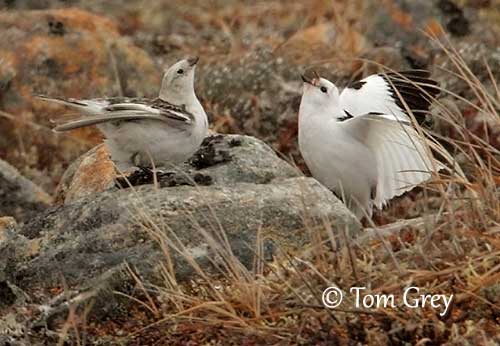

Bird list:
Black Woodpecker - Dryocopus martius - Pic noir
Boreal Owl - Aegolius funereus - Nyctale de Tengmalm
Brant Goose - Branta bernicla - Bernache cravant
Citrine Wagtail - Motacilla citreola – Bergeronnette citrine
Common Eider - Somateria mollissima - Eider à duvet
Common Goldeneye - Bucephala clangula – Garrot à œil d’or
Common Sandpiper - Actitis hypoleucos - Chevalier guignette
Eurasian Eagle-owl - Bubo bubo - Grand-duc d’Europe
Forest Wagtail - Dendronanthus indicus - Bergeronnette de forêt
Glaucous Gull - Larus hyperboreus - Goéland bourgmestre
Great Cormorant – Phalacrocorax carbo – Grand cormorant
Great Grey Owl - Strix nebulosa - Chouette lapone
Little Auk or Dovekie - Alle alle - Mergule nain
Long-eared Owl – Asio otus - Hibou moyen-duc
Merlin - Falco columbarius - Faucon émerillon
Northern Harrier - Circus cyaneus hudsonius - Busard d’Amérique
Peregrine Falcon - Falco peregrinus - Faucon pèlerin
Purple Sandpiper - Calidris maritima - Bécasseau violet
Short-eared Owl - Asio flammeus - Hibou des marais
Tufted Duck - Aythya fuligula - Fuligule morillon
Ural Owl - Strix uralensis - Chouette de l’Oural
White Wagtail - Motacilla alba - Bergeronnette grise
Yellow-browed Warbler - Phylloscopus inornatus - Pouillot à grands sourcils
Sources:
Aurélien Audevard
OUESSANT DIGISCOPING
SEVERNAYA ZEMLYA BIRD SPECIES
In the Russian high Arctic
Severnaya Zemlya is an archipelago that consists of four large islands and about 70 smaller ones. It lies in the Arctic Ocean, between the Kara Sea (west) and the Laptev Sea (east), at about 50 kilometres from mainland Siberia’s Taymyr Peninsula. The archipelago covers a total area of 37,000 km². It is uninhabited by humans, except for an Arctic base.
The climate is cold and quite dry, with temperatures ranging from -28°C in February, to +1°C in July. Cyclones are common in September and October, with 30% of annual precipitations.
Severnaya Zemlya is a polar desert with sparse vegetation including species of Cerastium and Saxifraga, and various species of mosses and lichens.
About 22 bird species can be observed on Severnaya Zemlya, with 17 breeding on the islands. However, 8 species are widespread on the archipelago and include Little Auk, Black-legged Kittiwake, Black Guillemot, Ivory Gull, Glaucous Gull, Snow Bunting, Purple Sandpiper and Brent Goose.
Several mammals are found on these islands such as Collared lemming, Arctic Fox, wolf, ermine, Arctic hare and reindeer. The Polar Bear population depends on ice conditions and prey availability, mainly seals.
Severnaya Zemlya was fist noted in 1913, but it was not put on the map until 1930-1932. These islands continued to be studied by geologists between 1948 and 1954, in order to provide a comprehensible geological map.
Text by Nicole Bouglouan
Sources for this text:
Wikipedia, the free encyclopaedia
Bird Observations in Severnaya Zemlya, Siberia
Polar bears of the Severnaya Zemlya archipelago of the Russian arctic
